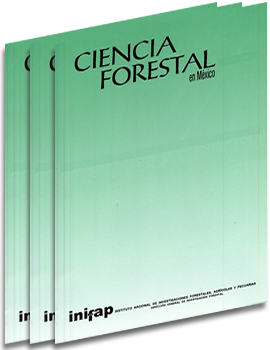ESTIMACIÓN DE PARÁMETROS GENÉTICOS EN DOS CICLOS DE CRECIMIENTO DE G/iricidia sepium (Jacq.) Walp.
Keywords:
Genetic correlations, stability, Gliricidia sepium, heredability, progeny test, growth selectionAbstract
In a Gliricidia sepium provenance and progeny essay established in the state of Veracruz, México, the genetic control (heredability) and phenotypic and genetic relationships between height, biomass production and plant architecture were assessed during two growth cycles in arder to determine the stability of genetic parameters between cycles. Seventy nine half-sib families from 9 seed sources were included in the field experiment. During the first growth cycle, individual-tree heredability for plant height (h = 0.35) was higher than for the other growth characteristics. Family heredability (h21) was higher than individual-tree heredability (h ) in ali characteristics. Both h 1 and h, decreased significantly from the first to the second cycle, associated to variation between plants in sprouting capacity and rate. The genetic and phenotypic correlations between height, growth, diameter and plant biomass were positive in both cycles. In this case, selection of the best families, regardless of seed source, could give a right response to selection.
Downloads
Downloads
Published
How to Cite
Issue
Section
License
The authors who publish in Revista Mexicana de Ciencias Forestales accept the following conditions:
In accordance with copyright laws, Revista Mexicana de Ciencias Forestales recognizes and respects the authors’ moral right and ownership of property rights which will be transferred to the journal for dissemination in open access.
All the texts published by Revista Mexicana de Ciencias Forestales –with no exception– are distributed under a Creative Commons License Attribution-NonCommercial 4.0 International (CC BY-NC 4.0), which allows third parties to use the publication as long as the work’s authorship and its first publication in this journal are mentioned
The author(s) can enter into independent and additional contractual agreements for the nonexclusive distribution of the version of the article published in Revista Mexicana de Ciencias Forestales (for example, include it into an institutional repository or publish it in a book) as long as it is clearly and explicitly indicated that the work was published for the first time in Revista Mexicana de Ciencias Forestales.
For all the above, the authors shall send the form of Letter-transfer of Property Rights for the first publication duly filled in and signed by the author(s). This form must be sent as a PDF file to: ciencia.forestal2@inifap.gob.mx
This work is licensed under a Creative Commons Attribution-Noncommercial 4.0 International license.



